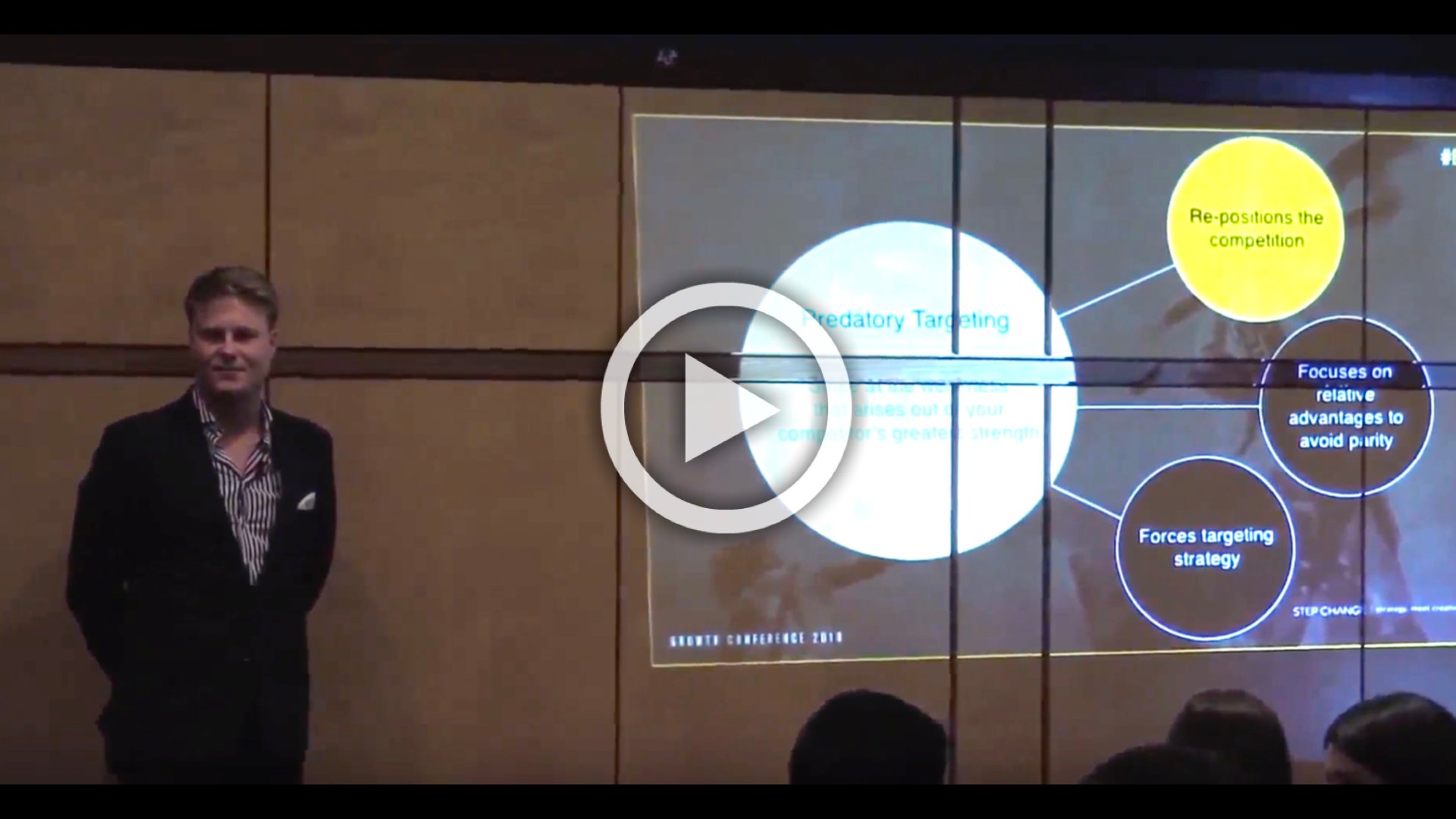This is the final in a series of four posts adapted from a Business Brain Food podcast where Jeff Cooper is interviewed by Ben Fewtrell of ActionCoach Business Coaching.
In this episode Jeff continues to share his insights and experiences on how Step Change Marketing used predatory marketing to gain market share from their key competitors and how you as a small or medium business owner can do the same.

In the third post of this series, 2 key tactics on how to market your small business message, I shared two ways of marketing your message before you spend a single dollar on advertising. In today’s post I’m going to give you some tips on how to get your marketing plan together.
Getting back to the ethos of Step Change, which is ‘steer clear of the bull’, the messaging that's being received by business people across, not just Australia, but the globe has led them to over-complicating things when they think about marketing.
Which social channel is the best?
My favourite saying on this is I went to a hairdresser and he told me that I needed a haircut. No surprise, right? You're on Facebook, and Facebook's telling you how it's the most effective medium and you've got to be on that. You switch onto Twitter and it says that, then you get a call from a radio station and they say that.
Human behaviour and human beings have responded to incentives since time immemorial, and you've just got to ask what people's motives are behind the messages that they're giving you. It has led to absolute confusion, because there's more media, more channels, more places to be talking.
When we work with small businesses, there's this overwhelming feeling of obligation, like, "I must be in social media." The reality is that social media is expensive in terms of time, and/or of course paid media along with it. Unfortunately, in the aid of selling and pushing a product and the outcome, what we've ended up with is a lot of confusion and a lot of obligation to be in certain channels.
It's probably one of the few reasons that, post‑GSC, we were able to open up as an independent marketing consultancy when the whole industry had been giving strategic services away as an incentive for them to buy other services, be it media or creative. It was really the market saying, "Actually, you know what? I will pay for that, as long as I know it's independent." Because “independent” means it's not going to be swayed by media.
If we recommend a client goes into radio, we won't make a dollar from that, unless of course we were to build the ads for them, which we do sometimes and other times we don't. Other times, we'll brief another agency or let them go direct to the media house.
I think that's the question you really want to ask. Whenever you see a stat or someone urges you to be in a channel, you need to ask what their motivation is. Listen to your small business friends, because they're the ones that will tell you honestly what their results have been, and at the end of the day, it's the results that make the difference.
If you're not getting a return on investment, it's not a good strategy. It doesn't matter how good they tell you it's going to be.
Tips on creating the small business marketing plan
Should you have a thorough marketing plan? Should it be a one‑pager? Do you really need one? Many small businesses ponder these questions and I would have to say definitely. You definitely want to have a marketing plan but at the same time you want to make sure that you're flexible around it.
The way that we work with our business ... and obviously, everyone under this roof is a marketer of some description ... we have a weekly marketing meeting where we call up major projects in our business. It's got all the things we're doing from a brand point of view, from a new business point of view, from a product development point of view, and all the stuff that we continue to be under marketing. We sit down with that and we just pick one off, get it done, and move on to the next.
If you are a small businesses, don't try and do everything. Try and do one thing well and then the next thing well. I guess what I'm saying is, keep that whip running so that you know what you're working on, but every time an idea comes up, make it someone's job to add that to what we call the idea pool. Then, of course, you never lose the opportunity to pull something out, elevate it or try something new.
I think for small businesses, with their ups and downs, the days of having that rigid, solid, 12 to 18 month plan are over. You need to be very, very responsive, and be constantly reviewing things and testing the results off the back end in whatever way you can, to make sure that your plan works for you every single month.
If you have identified your key competitors and what their greatest strengths are, then went through the five-step process as I showed you in a previous post, you could then put that into a calendar and say, "I'm going to target this one for the first quarter, this next competitor the second quarter," and then it's planned out, and if things change, you can move with it, you can flow with it. This is the very first step.
The other thing I'd like to touch on is that customer journey step-through. Really understand their media channels, the touch points, and audit them. I would say for most small businesses, if you did that thoroughly and looked at not only what they currently have, but also some of the things that might slot in to help them carry the messaging from that five-step predatory exercise, most of you would have enough work in there to keep you busy for a long time.
One of the things I ask when I'm talking to somebody is, "How many of your customers know 100 percent of everything that you do or offer?" The answer is scary, even for us. Sometimes we get busy, like any consultancy. We look at our own marketing and we think, "Geez, we’re the cobbler with the poor shoes." We've all been bitten by that snake, where you sit down with a client and they're like, "Oh, I just didn't know you did that." You're like, "Wow. I have to take responsibility for that." Scope of work and services is very important.
Using the one-four-seven rule
There's a rule here which is the one‑four‑seven rule. It costs a dollar to keep a customer, $4 to cross‑sell them, or $7 to get a new one. Basically it works in multiples. Any opportunity you have with a customer to tell them about a new service of yours, or something that could be of value that they haven't previously purchased, that is the highest return on investment activity you could be doing, almost all the time.
And you can use your current touch points, so you don't even have to instigate new marketing to make that happen. You can just install it into whatever. Like I said, find those touch points and make it a part of what you do every day.
Are you suffering from marketing fatigue?
As small business owners and as marketers, there's this horrible affliction. We're all sick. It's called marketing fatigue. What happens is that we get bored with our messages long before our customers have even noticed them. The way that your listeners want to think about things is they want to ask themselves the question, based on how complex and how attractive the information is they're putting out there, "How many times might I actually need to talk to someone for them to get it and take action?" The crib notes are … the research has been done ... it's somewhere between seven and twenty times, depending on those variables.
Again, when you talk about using existing channels and then you mix that with the realisation that you might need to tell someone about something 13, 14, 15 times in a valuable way, you really do want to make sure that from the time they engage in your business to when they leave, they're getting that repetition, that frequency of message.
What are some of the things that people get wrong in marketing?
I'll recap a few from earlier. The first one is optimise your own channels before you buy any media. The second one is to really question your online and your social activities. They may not have a media budget with them, but by the time you look at your time and investment, they can actually be very expensive channels to be in.
Make sure that your marketing plan is focused around retention first and cross‑sell second and then acquisition of new customers third, in that order, because the return on investment in that is absolutely key.
Have an understanding and try to put on your customers’ lens. We do a lot of work around people's value propositions, and where they're getting it wrong is that they're very good at explaining what they do, just not so great at explaining why a customer would care.
There are some opportunities differentiating around their process, such as how do we do it differently and why does that matter. Map out on a whiteboard key pain points or key criticisms of your category for your customers, and then try to alleviate that from your messaging.
Also, get out there and talk to your customers about what it is that you do, because you'd be surprised how little comprehension there is out there about your differentiators and what you do. I think that, unfortunately, a lot of customers are still talking at that very functional level, without moving into that, "Well, why would I actually care?"
If I'm trying to sell a marketing planning service to a CEO, it's not about the fact that we do a planning session. It's not about the fact that they get an 18 month calendar. I'm actually trying to close a gap in their budget to sales, and that's what I should be selling to them. I should be selling to them their growth targets, not necessarily my process and what it is that I do.
I think that would probably be at the core of it - just trying wherever possible to look at your messaging with fresh eyes and get input around it, because more often than not, we're finding that customers just don't really quite get what a client's business is doing which is amazing when you think about it.
I'm no different, being an owner of a business myself. We get caught up in what we do, and I think sometimes we forget to really articulate to a customer what sort of value we can bring them, and making sure they know what's available.
So go out there and give the predatory marketing thing a good go. Even if it just gets you a small percentage of your competitor's business, you’re a winner.
Before I go, I’d just like to remind you of our “Stump the Strategist” sessions. Basically it's our way of making sure that, without sending large invoices, we can actually help those people that just want to get a sense check on an idea, a strategy or a problem. It is run every second Wednesday so come and see us in action, we’d love to see you there.
You can get information at stumpthestrategist.com, or the very easiest way is just send me an email at jeff@stepchangemarketing.com, and I'll always be able to point you in the direction of our next session.
You can listen to the full podcast below:














